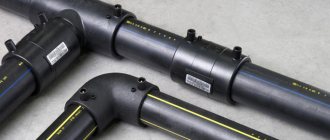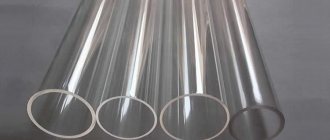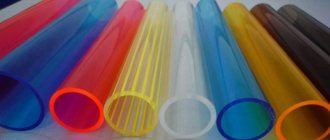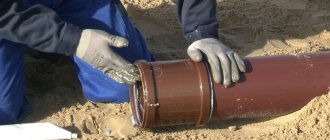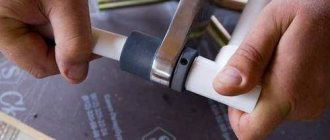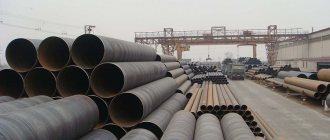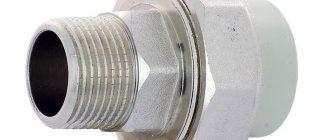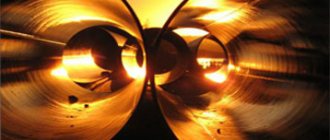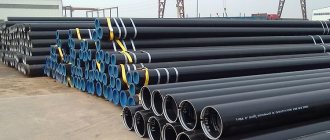Heat-resistant pipes
Often in everyday life and in industrial production it is necessary to dispose of waste of aggressive substances and combustion products.
But ordinary pipes are not suitable in such cases. This requires a heat-resistant pipe that can withstand high temperature loads. Heat-resistant pipes are made from heat-resistant, corrosion-resistant and heat-resistant alloys that comply with the GOST 5632-2014 standard. Among the main steel grades from which heat-resistant pipes are made are: 12Х13, 08Х13, 12Х18Н10Т, 10Х23Н18, 08Х22Н6Т and others. Also common grades of heat-resistant steels that are used for the production of pipes include: KhN77TYUR, KhN60VT, KhN32T, 36NKhTYu, KhN78T and others.
What should the products be?
If you need to install a chimney in a bathhouse or a gas duct for a fireplace stove, it is necessary that the pipe products used fully comply with existing standards. The products must contain nickel. The presence of molybdenum will make the structure even more durable and reliable.
The presence of sulfur and chlorine in the metal is not a problem. These components do not have a destructive effect on the alloy. Some steel grades contain titanium. The presence of this component avoids the formation of a large amount of carbide.
It is advisable to select pipes of the following brands:
- 10x1713MDT;
- 20х23Н18;
- 12х18Н10Т.
The specified grades of material are alloyed with titanium. They are used at temperatures from three hundred fifty to six hundred degrees. Steel 20x23N18 can be operated at temperatures up to one hundred and ten degrees.
The structures should not be uneven or damaged. Heat-resistant stainless steel pipes are not coated with a polymer coating. Because there is no need for this. Stainless steel itself is highly resistant to corrosion processes. In addition, this material is quite flexible. Therefore, installation of products is not a difficult task. The main thing is to mount the structures at the correct angle.
Products used for the installation of chimneys must be certified. Technical documentation is provided with the products. It confirms that the products meet the required parameters and have passed all the necessary tests.
Main types of heat-resistant pipes
Various chemicals that are carried by air, as well as strong heat, can transfer pipes cast from steel, which contains nickel and chromium. Due to its high carbon content, as well as nickel and chromium, this steel is classified as rust-resistant.
Heat-resistant pipes can be divided into the following main types:
- Heat-resistant cast pipes. These pipes are the most durable type; they are made on specialized pipe casting machines. The steel used for cast pipes is carbon and low-alloy;
- Seamless heat-resistant pipes. They can also be considered fairly durable pipes, since they are made from a single sheet of metal. Their diameter can reach up to 1500 mm. Due to their excellent properties, they are used for laying pipelines through which substances are cooled at a sufficiently high temperature;
- Welded pipes. In their production, sheet metal is used, it is first bent, and then its longitudinal seam is welded. In addition, this type of heat-resistant pipes is divided into spiral-seam and straight-seam. In the first, the seam runs in a spiral around the longitudinal profile of the pipe.
Kinds
Airborne chemicals and strong heat can be carried by pipes cast from specialized steel containing chromium and nickel. Such steel can be safely classified as rust-resistant, since the composition will contain a large percentage of chromium, carbon and nickel, which prevents rust from appearing on the surface of the pipe. Heat-resistant pipes that can withstand high temperatures can be divided into the following types.
Thin-walled, seamless and extra-thin-walled pipes made of heat-resistant and heat-resistant alloys KhN78T (EI-435), KhN77TYUR (EI-437B) according to TU 14-3-946-80
Welding types of heat-resistant pipes
To produce this type, sheet metal material is used, which is folded and then joined by welding, ultimately forming a pipe. They can be welded with a straight seam or a spiral seam. If it is longitudinal, then it is welded using spiral welding.
Pipes that can withstand high temperatures without seams
This type has greater strength and reliability than the previous type, since they are made from solid metal material. They reach 1500 millimeters in diameter. Seamless pipes have good positive characteristics and are used for laying pipelines through which highly chemical substances or substances with very high temperatures will pass.
Whole (cast) pipes
They are the most durable compared to their predecessors. They are made on special machines. The steel used for production is the one that contains the least amount of hydrocarbons.
We recommend: Stainless steel chimney pipe
heat-resistant pipes for furnaces and boilers
What are heat-resistant pipes used for?
According to their main purpose, pipes for high-temperature substances can be divided into several types:
- which are designed for use under high pressure and enormous loads;
- for installation in boiler rooms;
- for laying highways;
- structures used in oil production from wells;
- for draining gas or water;
- with different sections according to their profile;
- which are needed in chemical production.
Currently, heat-resistant pipes have begun to be produced from stainless steel; such pipes are produced mainly for chimney outlets. In such cases, the steel grade most often used is from the austhetic group, since it contains a fairly high amount of carbon, nickel, and chromium. Complementary elements give the steel a good plastic shape and ideal resistance to rust.
Made from stainless steel, they are quite good in their performance characteristics at very high temperatures. In order for a heat-resistant pipe to be safe, the thickness of its walls must be at least 0.5 millimeters.
If you don’t know where you can buy stainless steel chimneys for the stove, then we advise you to contact. The Company's warehouse is located in the Moscow region, but products are delivered throughout Russia.
What are the requirements for pipes that can withstand high temperatures?
Table of GOST and dimensions for heat-resistant pipe 20x23n18
Pipe application area
Heat-resistant pipes are widely used in industrial areas where sufficiently high resistance to corrosion at fairly high temperatures is required, as well as resistance to various aggressive environments. The main industries where heat-resistant pipes are used include aircraft and power engineering.
Also, according to their purpose, heat-resistant pipes can be divided into the following main types:
- used in boiler rooms;
- for drainage of water and gas;
- for laying highways;
- for the construction of structures during oil production from wells;
- for various chemical production;
- pipes that are used under high loads and pressure.
In addition, heat-resistant pipes made from stainless steel are used for chimney outlets. In this case, steel belonging to the austhetic group is often used, since it contains a fairly high amount of nickel, carbon and chromium. These elements add ductility and excellent corrosion resistance to the steel.
Scope of application
The products under consideration are divided into several options.
There are pipes on sale that are used for:
- removal of liquids and gases;
- oil production;
- chemical industry;
- boiler rooms;
- work under conditions of high pressure and heavy loads.
The most popular area of application of products is the installation of chimneys. For this task, products made from austhetic steel are best suited. It contains significant amounts of chromium, nickel and carbon. Additives make the material resistant to corrosion processes and give it a plastic shape.
Heat-resistant stainless steel pipes have high performance characteristics at high temperatures. The most reliable products are those whose wall thickness is at least 0.5 mm.
Below you can find a table of sizes and GOSTs for the types of products in question.
| Heat-resistant pipes 20x23n18 | ||||
| 20х23н18 | 76x12 | osv | used | GOST 9941-81 |
| 20х23н18 | 89x5 | dark | used | GOST 9940-81 |
| 20х23н18 | 89x4.5 | osv | used | GOST 9941-81 |
| 20х23н18 | 108x5 | osv | used | GOST 9941-81 |
| 20х23н18 | 108x8 | dark | used | GOST 9940-81 |
| 20х23н18 | 114x6 | osv | used | GOST 9941-81 |
| 20х23н18 | 121x6 | dark | used | GOST 9940-81 |
| 20х23н18 | 121x10 | osv | used | GOST 9941-81 |
| 20х23н18 | 140x8 | dark | used | GOST 9940-81 |
| 20х23н18 | 140x8-9 | dark | used | GOST 9940-81 |
| 20х23н18 | 152x8-9 | dark | used | GOST 9940-81 |
| 20х23н18 | 159x8 | dark | used | GOST 9940-81 |
| 20х23н18 | 168x13 | dark | used | GOST 9940-81 |
Requirements for heat-resistant pipes
These pipes are supplied cast, welded or seamless. In this case, special rods are used as blanks for the production of seamless heat-resistant pipes. These semi-finished products are supplied with or without heat treatment. They also produce a separate category of these products, having a wall thickness of 0.12 to 1.00 mm; they are called extra-thin-walled.
All main dimensions of heat-resistant, seamless corrosion-resistant pipes and all maximum deviations for them, mechanical properties, as well as delivery condition, are listed in the standards: TU 14-3-520-76, TU 14-3-571-77, TU 14-3- 582-77, and welded according to the standard - GOST 11068-81.
Heat-resistant pipes that are intended for a stove, bathhouse or fireplace must meet established standards - GOST 5632-2014.
Heat-resistant pipes, in addition to their basic properties, must have an aesthetic appearance; they should not have irregularities in the structure, as well as defects. Painting of pipes is excluded, and their anti-corrosion properties must meet the highest requirements.
The fire chimney pipe must have all the necessary documents, as well as a certificate. This confirms that the necessary fire tests have been carried out and proves that the material fully complies with the standards and relevant regulations. Also, due to its plasticity, this pipe can provide easy and quick installation of the chimney at any angle and in the required direction.
Requirements for fire-resistant pipe products
According to GOST 5632-61, heat-resistant chimney pipes for stoves, baths and fireplaces must be made from steel grades that must contain nickel. To give increased strength, molybdenum is added to the alloy, while chlorine and sulfur almost do not interact with the metal and do not destroy it. Titanium is often present in the composition, which promotes the formation of carbide. As a result, excess carbon combines in the steel and stabilizes it.
The pipe must have an aesthetic appearance; irregularities in the structure are not allowed. The manufacturing material cannot be painted, and the anti-corrosion properties of the pipes must meet the highest standards.
Due to the fact that heat-resistant pipes have such a quality as plasticity, it is possible to install chimneys in any direction and at different angles.
Chimney flame pipe products must have a certificate and other necessary documentation, which confirms the fire tests performed and full compliance of the manufacturing material with current norms and standards.
Heat-resistant brands include, for example, 08Х18Н10Т and 10Х17Н13МДТ. Pipe products made from such steel have an operating temperature from +350 to +600 degrees.
How to install a chimney?
There are different ways to independently remove pipes from a flue.
The most commonly used installation options are:
- The chimney is located inside the structure. It is necessary to install the pipe structure next to a partition or wall.
- The gas duct is located outside the building. The diagram is used if the heating system is located in a finished building.
- The sleeve installation method is used to improve or repair an old brick chimney.
Types of chimney pipes
Stove pipes and chimneys can be divided into several large groups depending on the material they are made of. So they can be made using brickwork, from metal pipes of various types, as well as from multilayer materials.
In addition, stove chimneys may differ in the way they are installed:
- Wall chimneys are mounted directly into the thickness of the walls of the building, external or internal. In this case, stoves and fireplaces can also be installed directly in the walls of buildings.
- Suspended chimneys are mounted on the external walls of buildings.
- There are also main chimneys. Such structures are mounted separately, next to the stove.
